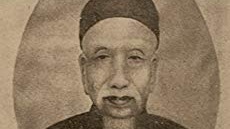Liang A-Fa: China's First Preacher
In this reprint of George Hunter McNeur’s biography of Liang A-Fa from the 1930s, Jonathan Seitz adds a critical introduction as well as notes and a glossary. The wider availability of McNeur’s biography helps to fill a gap in the history of Christianity in China, as there is a noted lack of biographies on early Chinese Christian leaders. As Liang A-Fa was the second known Chinese Protestant convert and the first ordained Chinese Protestant preacher, he is an important figure in the history of Christianity in China and deserves to have his story told. (For a short biography of his life, see the Biographical Dictionary of Chinese Christianity.) Recognizing the value of McNeur’s work, as McNeur had access to people and sources no longer present, Seitz chose to republish this biography.
Seitz begins his introduction by offering insight into the original biographer, George Hunter McNeur, who served as a missionary in China. He goes on to analyze the available body of writing on Liang’s ministry, which includes just two biographies. He then describes Liang’s famous book, Good News to the World, the one major work of Liang’s that was unavailable to McNeur at the time of his writing. Although Good News was labeled as a tract, it was over five hundred pages in length and was primarily a collection of Bible stories, written in a Chinese style resembling “morality books.” Good News also includes Liang’s conversion account and a section condemning Chinese religion.
In his introduction, Seitz also discusses at length the enduring legacy of Liang. He identifies and explores several key roles that Liang modeled for Chinese Protestants. These include: convert, firstfruits, confessor, ordained leader, evangelist, polemicist, social critic, and theologian. Most of these themes are developed in depth in McNeur’s writing, but Seitz provides additional information from Good News to introduce and explain these ideas. Liang’s own words add to the account of other missionaries that we read later in McNeur’s writing. We get a more complete picture of Liang A-Fa by learning how he understood his own calling. Seitz concludes the introduction with a recommendation of McNeur’s words in the pages following his opening and expresses his hope that a reprinted biography will draw more attention to one of Christianity’s major figures.
McNeur’s biography offers a straightforward narrative of Liang A-Fa’s life. It tells an important chapter in Chinese Protestantism. Many of the chapters include illustrations, some of which are reproductions of Liang’s family materials.
Beginning with the story of the surroundings into which Liang was born, McNeur paints a picture of what life was like for Liang during the years of his upbringing. Although there are no written records of his early years, McNeur presents evidence that he was poor, and he constructs for us a satisfactory depiction of what the young Liang would have experienced during that time period. McNeur describes Liang’s journey to Canton (Guangzhou) to find work as a block cutter, and how his occupation led to his meeting Robert Morrison. When Liang moved to Malacca to assist William Milne as a printer, he began seeking after God. McNeur traces the influences that led to this change and gives a detailed account of his baptism. He then recounts how Liang returned to Canton to get married and later baptized his wife himself.
In the latter half of the book, McNeur details Liang’s work in converting Chinese to Christ. He opened a Christian school for boys, wrote tracts, and distributed books. Since Christian preaching was a capital offense in China at the time, conversational evangelism was the only method available to Liang. McNeur uses an account from Liang’s journal about attempting to lead an innkeeper named Mr. Lam to faith in Christ to illustrate how Liang went about his evangelistic work. McNeur also addresses how Liang’s disposition gradually changed for the better as he matured in his Christian faith.
Liang A-Fa’s most fruitful years were between 1831 and 1834. This period saw Liang baptize several new believers. In one year, Liang printed seventy-thousand tracts, many of which he distributed to candidates for examination in Guangzhou. According to McNeur, one of the students to whom Liang handed a set of his tracts was Hong Xiuquan (Hung Siu-tsuen), the eventual leader of the Taiping Rebellion. One day, while Liang and his assistants were working at the examination hall, the police arrested one of Liang’s assistants and seized their tracts. Liang escaped with his wife and daughter, but soldiers searching for him seized several of his relatives in Samchow. Eventually, ransom money was paid and those who had been arrested were released.
During the mid- to late-1830s, Liang worked in Malacca and Singapore with many of the major missionaries of the day. Liang felt called to preach the gospel to his own people, however, and returned to Guangzhou in 1839. There, he served in Dr. Peter Parker’s hospital, visiting with patients. In 1845, he became the hospital evangelist, holding regular Christian services. In 1848, he moved to Dr. Benjamin Hobson’s hospital to become the evangelist there. Liang began to realize his strength was gradually failing, but he would not give up his work at the hospital. He continued his preaching, even up to the days preceding his death on April 12, 1855. McNeur concludes his biography with a brief chapter on Liang A-Fa’s legacy and the life of his son.
Seitz’s annotated reprint of McNeur’s original work is indispensable reading for anyone interested in Chinese Christianity. Liang A-Fa is an often forgotten figure who deserves more scholarly study. Seitz has made this important biography more accessible to the English reader. Liang A-Fa’s contribution to Protestantism in China warrants him more recognition among academics today, and McNeur’s reconstruction of Liang A-Fa’s life in this republished biography will hopefully accomplish just that.

